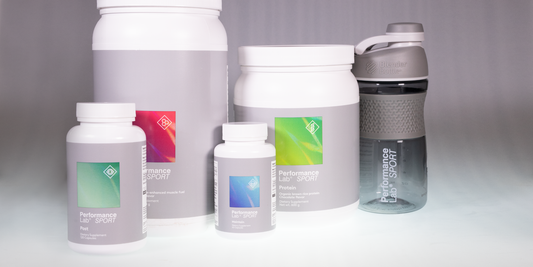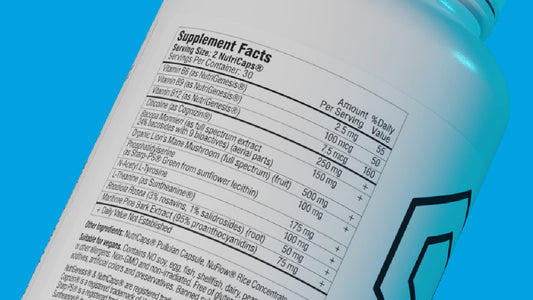What the hell is NutriGenesis®...?
And what does 'nature-identical' mean...?
Two good questions.
After all, you don't find NutriGenesis® in any ordinary multivitamins. And 'nature-identical' nutrients sound too good to be true.
It's no wonder it sparks curiosity.
But relax, we are about to explain everything about our nutrient forms. And what makes them so special.
Let's start with the basics and define what exactly is NutriGenesis®.
Key Takeaways
- NutriGenesis® is a way of cultivating vitamins and minerals in a living food matrix so they are structurally similar to nutrients found in whole foods.
- This food-identical approach improves bioavailability and tolerance compared to many synthetic isolates and mega dose formulas.
- NutriGenesis® couples precise, standardized dosing with natural cofactors, delivering nutrition the body can recognize and use more efficiently.
- The process uses plant and yeast cultures to grow nutrients alongside proteins, carbohydrates, enzymes, and antioxidants for a whole food like profile.
- Choosing NutriGenesis® based supplements helps you get cleaner, eco conscious micronutrient support that better matches how your body is designed to absorb nutrients.

What is NutriGenesis®?
The Definition of NutriGenesis®
If we break down the word NutriGenesis® into two parts you get "nutrient" and "genesis."
"Nutrient" means the vital nourishment needed for life and growth, while "genesis" stands for the origin or formation of something.
NutriGenesis® uses the very latest nutritional technology to cultivate nutrients. In a way that replicates the creation of vitamins and minerals in nature.
In other words, NutriGenesis® vitamins and minerals are identical to those you can naturally find in food.

Origins of NutriGenesis®
The backbone of NutriGenesis® technology is based on the work of Nobel Prize-winning Hungarian chemist - Albert Szent-Györgyi.
In a Nature article from July 4, 1936, Szent-Györgyi noted that giving pure vitamin C to patients with weakened blood capillaries did not enhance their function. By contrast, the extract from whole red peppers or lemon juice - rich in vitamin C and accompanying flavonoids - fully restored their natural resistance. (1)
This led to the theory that nutrients presented in their naturally grown forms supply cofactors that make them more bioavailable and biologically active. So they are more effective than nutrients that are chemically isolated.
Almost 100 years later, this key discovery inspired the game-changing innovation of NutriGenesis®. While most ordinary supplements still rely on technology that is decades old.
NutriGenesis® versus other nutrient forms
As you stroll down the supplement aisle in your favorite health store, you'll likely come across products with the following nutrient forms:
-
Isolated chemical nutrients (USP). These come in synthetic forms like zinc or magnesium oxides, cyanocobalamin, ascorbic acid, and so forth. Because they lack natural cofactors - that is, the synergistic compounds found in whole foods - USP nutrients might be poorly bioavailable. Their chemical structure may also differ from the forms present in food. Potentially making the processes of absorption and utilization even trickier. (2)
In an attempt to tackle these challenges, some companies may resort to mega-dosing. Boosting the concentrations of these isolated nutrients to make up for low bioavailability. However, mega-doses may result in undue strain on your system. Ending up with your body saying - 'thanks, but no thanks' as it flushes out the excess nutrients.
- Chelated minerals. These are minerals bound to organic molecules such as citrate, glycinate, picolinate, malate, etc. Even though chelated minerals usually have better bioavailability than USP nutrients, they're still missing essential cofactors that occur naturally in whole-foods. (3)
-
Whole Food Concentrates (WFCs). These are concentrated forms of vitamins and minerals derived from real foods. Products containing WFCs are typically labelled with phrases like 'whole food blend' or 'fruit and vegetable' concentrate. WFCs supply natural cofactors, but their production may raise ecological concerns due to pesticide use, extensive processing, or unsustainable agricultural practices.
Achieving precise nutrient dosage in each batch is also challenging due to variations in soil quality and growing conditions. (4) (5)

So, how does NutriGenesis® stack up?
Unlike the ordinary supplement options out there, NutriGenesis® vitamins and minerals are bound to natural cofactors. So they're like the identical twins of the nutrients found in your food. And - just as important - production involves minimal processing and has a low environmental impact.
The Key Advantages of NutriGenesis®
-
Nutrients are cultivated with natural cofactors, making them identical to those found in food sources. Maximizing nutrient uptake, bioavailability, and beneficial activity.
-
100% clean and safe. Produced under strict, controlled conditions. Free of pesticides or herbicides potentially associated with other whole-food nutrients.
-
Eco-friendly: Minimally processed with a small carbon footprint.
-
Precise dosage: Cultured through a standardized process ensuring reproducible outcomes and accurate dosing. High bioavailability diminishes the necessity for resorting to mega doses.
-
Patented and researched: Demonstrating superior bioavailability when compared to chemical isolates.
The Scientific Take on Food-Identical Versus Isolated Nutrients
There is lots of scientific literature to support the higher efficacy of food-identical vitamins and minerals compared to isolated nutrients.
A study was done to compare the bioavailability of synthetic vitamin C - ascorbic acid (AA) - versus natural citrus extract containing bioflavonoids. It showed that the AA was rapidly absorbed - but the excess was subsequently excreted. While the natural vitamin C was released more gradually, so absorbed slowly. (6)
The result? The natural vitamin C was found to be absorbed 35% more effectively than the synthetic counterpart.
Another study compared the biological availability of mineral chelate - specifically zinc gluconate - with yeast-derived zinc. This also indicated a significantly higher bioavailability of the food-identical nutrient. (7)
After 48 hours, the natural zinc supplement showed an increase in net zinc balance in the body. But supplementing with zinc gluconate salts ended up causing a net loss of zinc (!) due to elevated excretion rates.
Lesson learned: You can't fool nature!
How NutriGenesis® nutrients are produced
It is clear that Mother Nature knows best. And trying to reinvent the wheel with synthetic, isolated nutrients simply doesn't cut it.
NutriGenesis® draws inspiration from this wisdom. Applying the very latest nutrition technology to harness the power of nature. So we can replicate it, creating vitamins and minerals that are structurally identical to the nutrition we get from food.
So, what does this process look like in practice? Let's see how NutriGenesis® nutrients make their way from cultivation to capsule. From the pristine botanical setting in which they are grown, to the palm of your hand.

- Planting. Seed nutrient (such as mineral salt) is embedded into a hydroponic matrix.
- Germination. A growth culture that naturally nourishes the seed nutrient is incorporated into the matrix. NutriGenesis® growth cultures include: Daucus sativus (carrot) and Medicago sativa (alfalfa) and Saccharomyces cerevisiae (Brewer's Yeast).
-
Growth. NutriGenesis® cultures absorb mineral salts, micronutrients and water. The well-nourished nutrient culture grows - dividing from one cell into two, two into four, and so on. As the live cells divide, they naturally grow new vitamins and minerals within a matrix of cofactors including:
- Proteins (essential and non-essential amino acids)
- Complex carbohydrates (beta-1,3-glucans and mannan)
- Digestion-supportive probiotics, prebiotics and enzymes
- Antioxidants SOD (superoxide dismutase) and GPx4 (glutathione)
Because they match the natural nutrients-with-cofactors structure of whole foods. NutriGenesis® nutrients can be more easily recognized, absorbed and utilized by the body.
- Harvest. When cultures reach maturity, the lab-grown NutriGenesis® vitamins and minerals are collected, washed with purified fresh water and dried. Following these steps, NutriGenesis® material is ready to be used in supplement formulations.
Now that we've laid out the process, you might be thinking, ''Sounds great, but... I'm still curious about the specific form of [insert a vitamin or mineral] you use?"
Right, let's clarify.
The forms of NutriGenesis® nutrients
If we listed all the nutrient forms on our labels, they'd uniformly say 'yeast/botanical-derived.'
Any food-identical vitamin or mineral is embedded within a complex matrix of nutrients, often comprising a mix of various bioactive forms.
That's why we cannot state the form in the same way as you'd usually see in traditional multivitamin formulations that use standard isolated nutrients.

The reassuring news is that we've established that food-identical nutrients are highly bioavailable and easily put to use by the body. And, of course, when it comes to choosing supplements the most important question of all is - are they safe and do they work?
Okay, that's TWO questions. But with NutriGenesis® the answer is the same: Yes. And yes.
Are our B vitamins methylated?
MTHFR gene mutation is a genetic polymorphism that may affect your body's ability to process vitamin B9, also known as folate.
Methylated forms of B vitamins are often recommended for individuals with MTHFR gene mutations, but the situation is nuanced.
In the NutriGenesis® process, methylcobalamin serves as a starter culture for vitamin B12, while folic acid is a starter culture for the production of vitamin B9.
The end product, our food-identical, yeast-derived vitamin B9 typically contains a mixture of naturally occurring folates. (8), (9)
These natural folates tend to be more efficiently utilized than synthetic folate, even among those with an MTHFR gene mutation.
A recent study was carried out to test how doubling the intake of food-derived vitamin B9 would influence the folate status in people with a 'healthy' genotype compared to those with the MTHFR 677 TT mutation.
Interestingly, the results showed significant increases in serum folate concentrations in both groups, regardless of the genotype. (10) Proving the power of food nutrients yet again.
Final Thoughts

Not all supplements are created equal.
The human body is a wonder of biology. The ultimate high-performance machine. Fine-tuned over millions of years to recognise and absorb exactly what it needs. And to flush out what it doesn't.
Vitamins and minerals that are chemically isolated in production can be harder for the body to recognise and utilize. So you could be peeing any benefits - and your money - straight down the drain.
NutriGenesis® nutrients are cultivated with natural transporters and cofactors. Making them 'nature-identical' for maximum health benefits.
Just like nature intended.
References
- https://www.nature.com/articles/138027a0
- https://bmcnutr.biomedcentral.com/articles/10.1186/s40795-016-0121-3
- https://pubmed.ncbi.nlm.nih.gov/24259556/
- https://www.cabdirect.org/cabdirect/abstract/20123348584
- https://onlinelibrary.wiley.com/doi/abs/10.1111/j.1745-4557.1990.tb00004.x
- https://www.sciencedirect.com/science/article/abs/pii/S0002916523162964
- https://link.springer.com/article/10.1007/s12011-007-0072-2
- https://www.sciencedirect.com/science/article/abs/pii/S0924224405000816
- https://www.sciencedirect.com/science/article/abs/pii/S0924224405000816
- https://www.sciencedirect.com/science/article/abs/pii/S0955286305003128
















